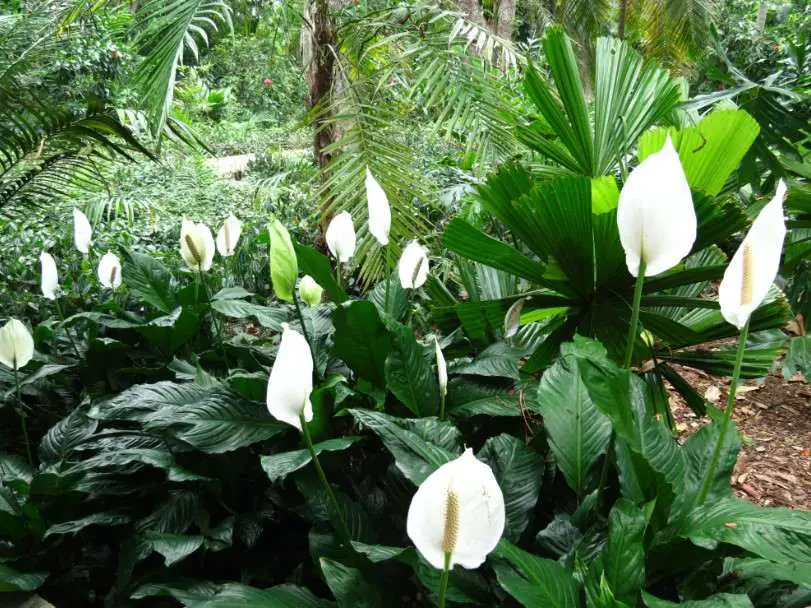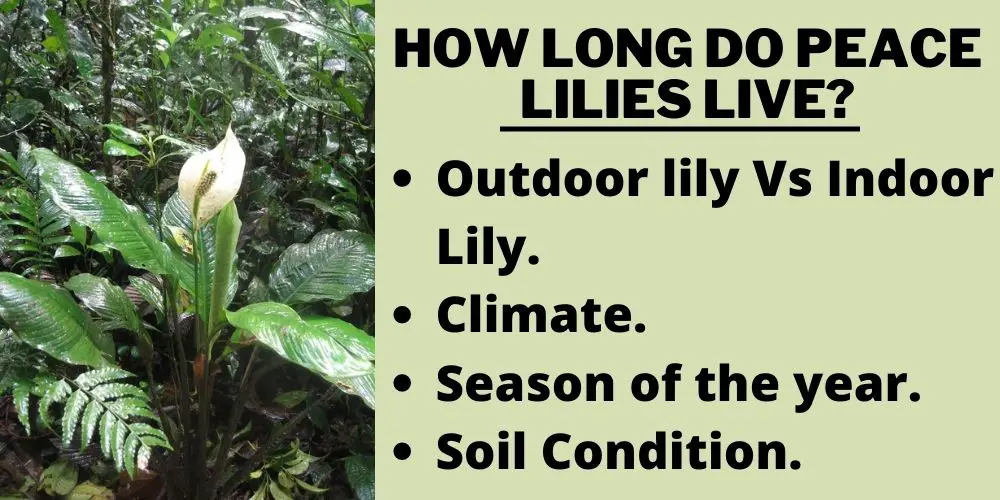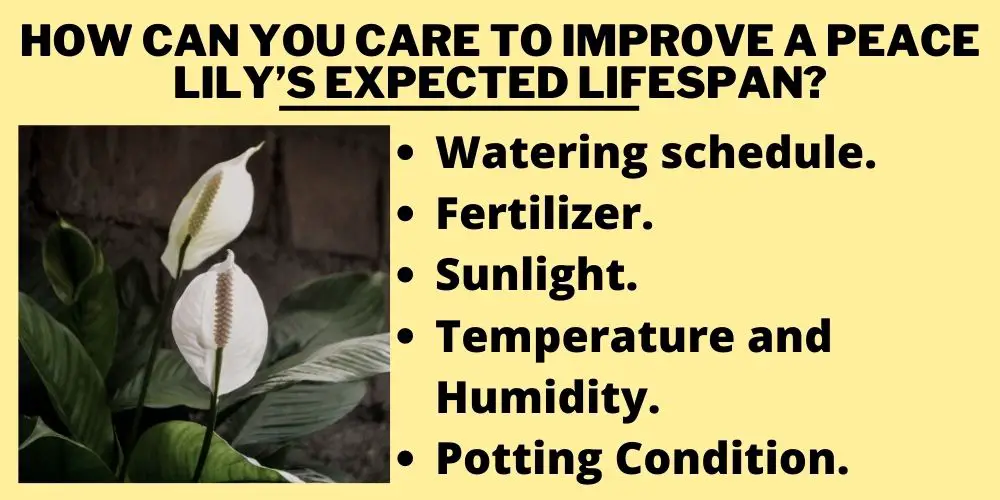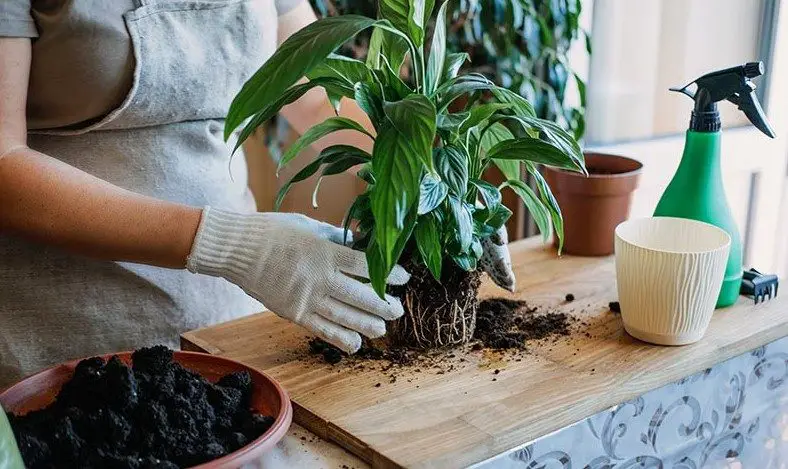Peace Lilies are those beautiful, typically white spathe-shaped flowers often used at funerals. They are said to signify purity, eternal life, rebirth and radiance. Surprisingly, these pretty white numbers offer some amazing benefits that few know about.
Not only can they improve indoor air quality but also increase the humidity, which as a result, can help you breathe better. It does this by breaking down and neutralizing any nasty toxic gasses such as carbon monoxide and formaldehyde.
But, how long do peace lilies live?
The lifespan of peace lilies ranges between 3 and 5 years depending on their growing environment and/or conditions.
For example, Peace Lilies won’t survive in colder conditions. They have almost zero tolerance for the cold. Additionally, keeping them warm and away from harsher elements like the wind can greatly increase their life expectancy.
In this article, our detailed research will cover their lifespan, how you can improve their lifespan, discover problems and solve those issues with manageable steps. Let’s dive in, shall we?

Table of Contents
How Long Do Peace Lilies Live?
There has reportedly been a myth about whether a peace lily can live forever, but that rumor was debunked long ago. No flower can live forever. Peace lilies have a lifespan of between 3 and 5 years.
The length will ultimately depend on its growing environment and conditions.
Although they are tough plants, they can’t last all that long. There have been some cases where a peace lily has lived longer than 5 years, but they are few and far between. Those instances were grown indoors and monitored with extreme care.

Outdoor lily Vs Indoor Lily
There may be a slight difference in lifespan when growing a peace lily outdoors vs indoors.
For example, an outdoors plant will battle harder against climate, seasons and winds. In contrast, an indoor lily can be controlled a little better. Controlling growth is a sure way to optimize a plant so that it has every chance to last as long as possible.
Climate
Peace lilies are a tropical type of plant. They thrive best in temperatures above 70°F (21°C), although they can still grow in temperatures as low as 60°F (16°C). These plants don’t do well at all in colder climates. Anything below 40°F (4-5°C) can shock them and ultimately end their life.
Season of the year
Peace Lilies grow best in the warmer months. When winter comes around, they will need to be protected a little more to keep them alive, depending on where they are geographically located.
It’s advised to keep them away from non-insulated windows and doors during the winter due to cold drafts that will most definitely harm them. Another issue that comes out of the colder months is the low humidity caused by heaters. Brown tips on the leaves are a visual sign of damaging low humidities.
Soil Condition
The soil requirements for a happy plant of this nature are a bit of a balancing act. They need drainage but also water retention and aeration. Blending potting mixes with materials containing a bit of texture, such as bark, can be advantageous.
Perlite, peat moss, coir, or loam are better mixed materials. The pH of the soil should be between 5.8 and 6.5.
How Can You Care To Improve A Peace Lily’s Expected Lifespan?
A few minor factors need to be considered if you want to improve the lifespan of a peace lily. If you can optimize these conditions within a welcoming environment, you will have a plant that has every chance to thrive for years.

Watering schedule
These tropical beauties don’t mind a good watering. In a normal environment, they can be watered every 2 days. In drier, warmer climates, they will likely need to be watered daily. If your lily is growing in humid conditions, you may be able to get away with only watering once or twice a week.
Whatever the case, always listen to your plant. Take note of how it looks and be mindful of its soil conditions. They will ultimately help you decide when it’s time for a drink.
Fertilizer
Peace Lilies don’t need any out-of-the-ordinary type of fertilizer. They can flourish pretty well with a standard house plant blend.
As long as it’s water soluble, good quality and has a well-rounded ratio of 20-20-20, they will be happy when it comes time to feed and dilute the solution to a ½ or ¼ strength. I usually water straight after fertilizing to allow the solution to soak evenly down the roots.
Sunlight
Peace Lilies love sunlight but not direct. They can dry out, scorch and burn if placed in direct sunlight. Allow 10-12 hours of indirect sunlight per day if possible.
If you are located somewhere that doesn’t offer much sunlight; you can also use fluorescent lighting to simulate the sun. If this is the case, the lilies can receive 16-18 hours of artificial light daily.
Temperature and Humidity
Since a Peace lily is a tropical plant, they love warmer temperatures and higher humidity. These plants flourish in temperatures above 70°F (21°C). It’s not uncommon for them to enjoy temperatures as low as 60°F (16°C). Peace lilies don’t fare too well in colder climates.
When the chill drops below 40°F (4-5°C), it can shock them, causing real damage or, in the worst case, kill them. If possible, try to place your plant around a humidity above 50%. Anything above 60% is an even bigger bonus. The bathroom or kitchen are great areas for higher humidity levels in the household.
Potting Condition
A peace lily thrives best in a larger container than its root ball. As the plant grows, you should only increase the pot size slightly to avoid damp potting mix around the roots, which can cause root rot. Ideally, the soil should be kept consistently moist but not soggy.
Use materials such as perlite, peat moss, coir, loam, and bark to assist with drainage, moisture retention, and aeration. The balancing of these requirements may take a bit of trial and error to perfect.
Keep an Eye on the Problems And Find The Solutions
Some notable issues that can arise when growing peace lilies are root rot, bolting and pest problems. They can all be controlled with the right knowledge and a good plan. Let’s look at the issues and their solutions in more detail.

Root rot
Root rot is often caused by either having a pot that is too big, the wrong type of soil or overwatering. I always try to have a pot that is only slightly larger than the root ball of my lilies. I gradually increase the pot size as the lily starts outgrowing them.
When a pot or container is too big, the greater volume of soil soaks in more water and holds it there to stagnate and bathe the root system. The roots stay moist and rot as a result. This issue also results from a wrong choice of potting mix and overwatering.
Too much water can often become trapped in poorly draining soil. Again, the plant’s roots sit in the water and rot out.
Bolting
Like any plant that can succumb to stress, a peace lily is no different. Bolting occurs when a plant goes through certain stressors, such as increased length of daylight, high soil temperatures, and root stress. The visual signs are noticeable.
A thicker, more tough stalk, lined with only a few leaves, suddenly pop out of the plant’s foliage. This can be avoided by moving the plant away from the sunlight, especially somewhere a little darker, to cool it down. Also, replanting in a pot only slightly larger than the root ball will help relieve the situation.
Pest Control
Aphids, mealybugs, spider mites or harbour slugs are the most common intruders to attempt colonization on a peace lily. They generally arrive if the plant is overwatered. They will latch onto the stems and leaves, sucking the plant dry of all its moisture, turning it brown and spotty.
They can be eradicated by rubbing alcohol or neem oil and gently dabbing the infested areas to kill them. Alternatively, it is possible to cover the plant with a plastic bag and seal it tight. Then gently rinse it in the shower or a sink to flush them away.
Frequently Asked Questions (fAQs)
Can a Peace Lily survive if it is grown inside water?
Peace lilies can be grown and survive in water alone. You can often find them for sale in clear vases without any soil. They are suspended slightly above the water by either a waterproof insert or some well-placed river stones.
What should I do if my Peace Lily has finished flowering?
Each stalk will produce only one flower. Once this has occurred, the flower and its stalk will turn brown, shrivel up and die. You should cut the dead stalk as low as possible to the base of the plant. This will allow new stalks to grow and go through the same process.
How do you revive an old peace lily?
Firstly, you should clean it up by removing any dead or dried-out parts. Give the soil a good amount of water and ensure that the water drains away from the plant to ascertain that the drainage is adequate. Keep an eye on the plant over the next few days, watering every time the soil dries out. Don’t let it become bone dry, though. You should start to see new stems begin to grow within the week.
Conclusion:
It’s fair to say that a peace lily can last 3 to 5 years if it is grown and maintained under optimal conditions. Any longer is a bonus but not typical.
The most common factors affecting its lifespan are climate and weather, soil conditions, watering frequency, sunlight and nutrient availability. We hope this well-researched article has helped you understand how long peace lilies can live.


